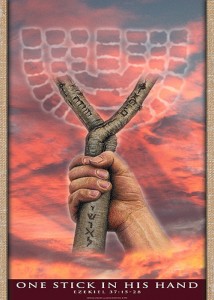Ezekiel 37:14–28, The vision of the two sticks (trees). The second vision Ezekiel records in chapter 37 involves YHVH commanding him to take two sticks (or trees) and writing upon one stick “for Judah and for the children of Israel and his companions [i.e., those who have knit themselves together with or joined to the tribe of Judah],” and upon the other stick, write “for Joseph, the stick of Ephraim, and for all the house of Israel and his companions.” Ezekiel was to then join the two sticks together so that they would become one stick (or tree) in his hand (verses 15–17).

Image courtesy of messianicisrael.com
How were these two nations, which separated from each other some three thousand years ago, to be rejoined into one nation? That has been the subject of much debate between both Jewish and Christian commentators for years. Some modern historical revisionists view this prophecy as having been fulfilled when the Jews returned to the land of Israel in the time of Ezra and Nehemiah after their Babylonian captivity ended. But this interpretation leaves some unanswered questions. The book of Ezra, which chronicles the return of a remnant of Jews from Babylon to the land of Israel, lists the numbers and tribes of those who returned. All the tribes listed were originally from Jerusalem and Judah and were from the tribes of Judah and Benjamin (Ezra 2:1; 4:1; 10:9), and there is no mention made that any of the ten northern Israelite tribes joined the Jews in resettling the land of Israel. So far as the returning Jews were concerned, it is likely that they considered their northern brothers lost and assimilated among their Assyrian captors and that only they were left of all the twelve tribes to resettle the Promised Land. If this were so, this may explain why they considered themselves to be “all Israel” (Ezra 2:70; 6:17), since they considered themselves to be the representative remnant of all the twelve tribes, even though their numbers did not consist of the twelve tribes of Israel.
Furthermore, how do those who teach that the prophecy of the two sticks has already been fulfilled explain how anytime in Israel’s past history the two sticks became one nation, and how the once scattered twelve tribes of Israel were regathered from the nations of the world, and how all were resettled in their own land (Ezek 37:21)? Whenever in the past did all the twelve tribes of Israel completely disassociate themselves from the pollution and defilement of paganism and start serving Elohim in perfect righteousness (Ezek 37:23)? Moreover, has David ever been resurrected from the grave to rule over the regathered and reunited Israel as this prophecy declares will happen (Ezek 37:24–25)? After all, the Scriptures tells us that David is dead and buried to this day (Acts 2:29), and awaits the resurrection of the saints at the second coming of Yeshua. Continue reading →




